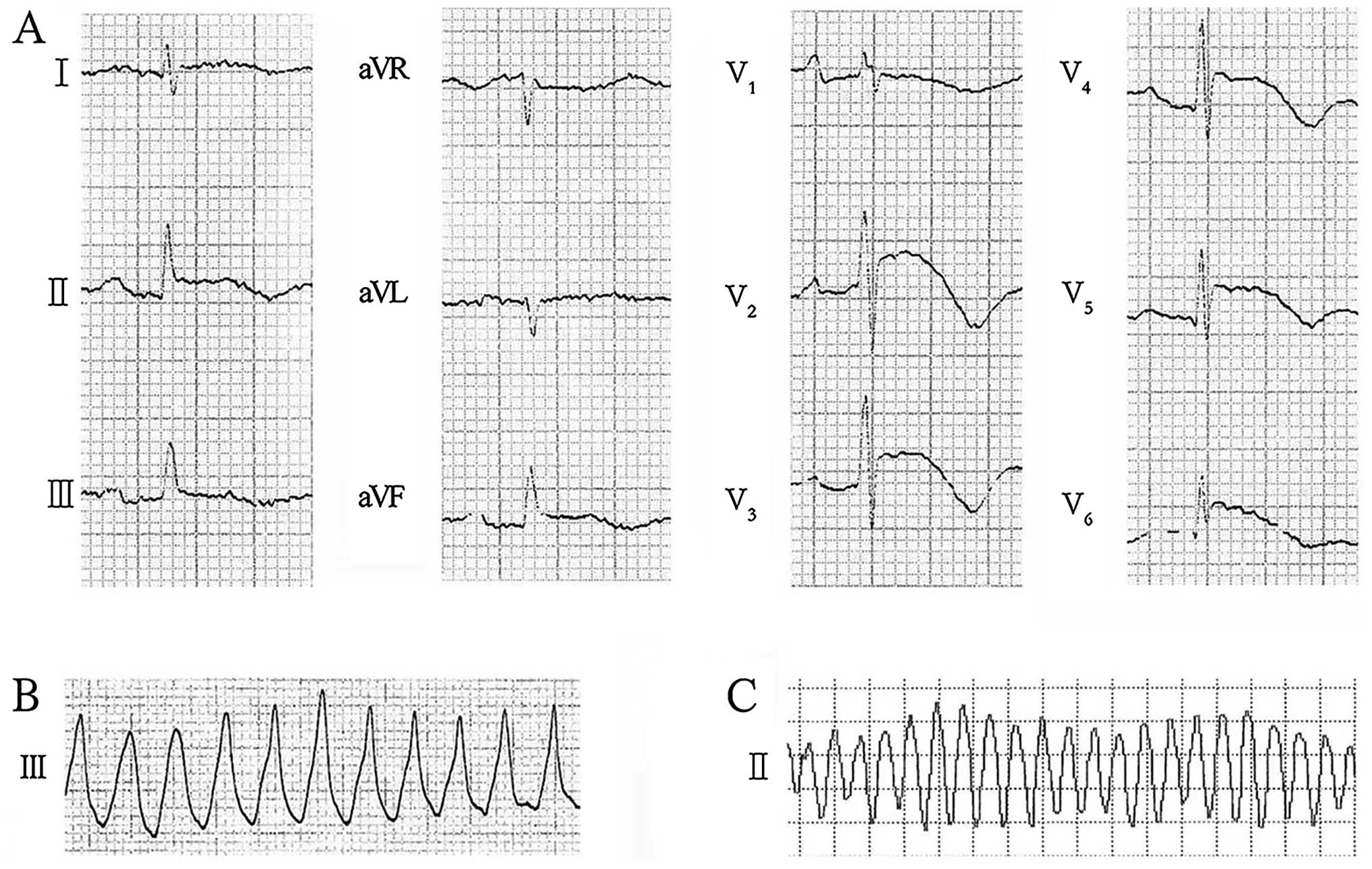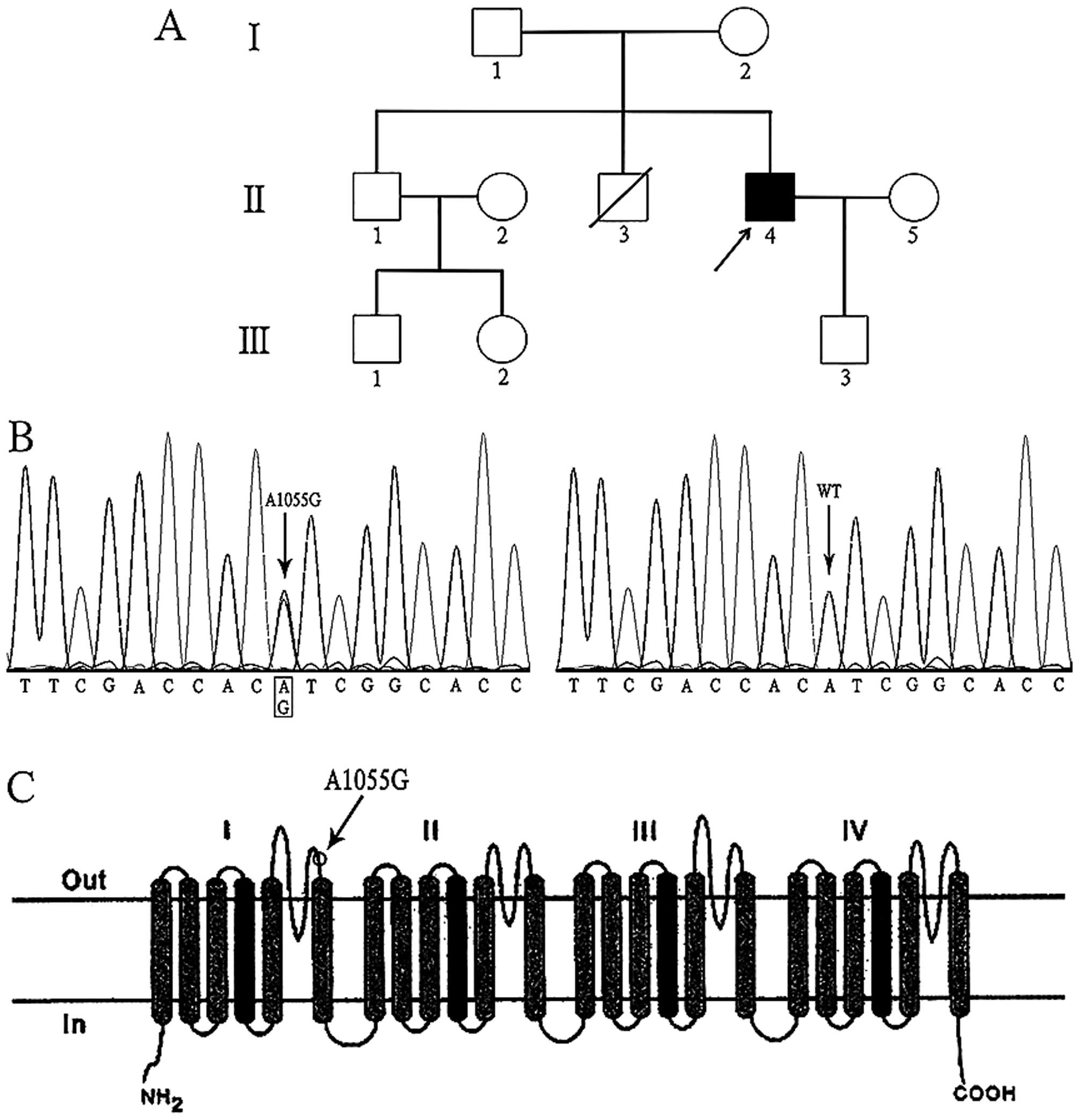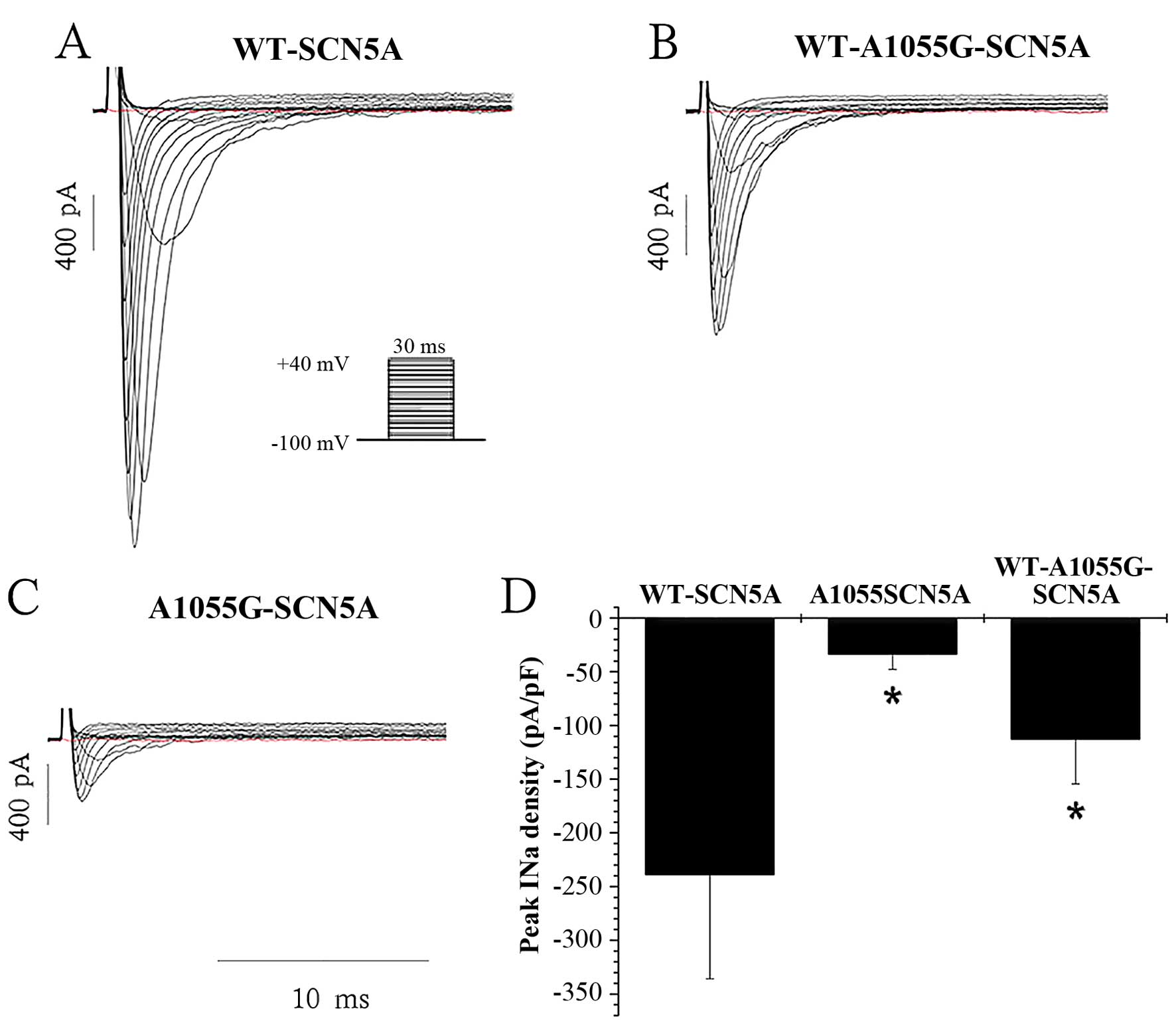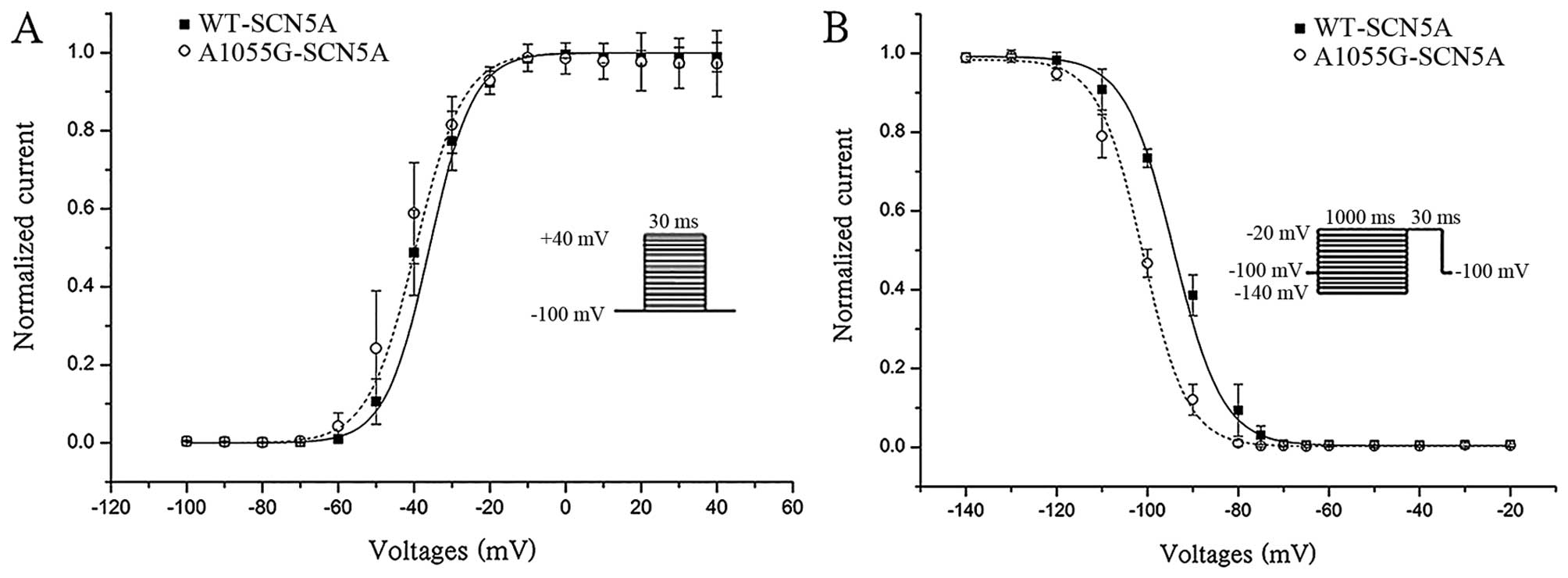A novel mutation in the SCN5A gene contributes to arrhythmogenic characteristics of early repolarization syndrome
- Authors:
- Published online on: January 26, 2016 https://doi.org/10.3892/ijmm.2016.2468
- Pages: 727-733
-
Copyright: © Guo et al. This is an open access article distributed under the terms of Creative Commons Attribution License.
Abstract
Introduction
The early repolarization (ER) pattern on the electrocardiogram (ECG) is defined as ≥0.1 mV J-point elevation of either notched or slurred morphology in at least 2 contiguous inferior and/or lateral leads. It was first described as a common ECG variant in healthy human subjects in 1936 by Shipley and Hallaran (1). For a long time, the ECG pattern of ER has been regarded as a benign phenomenon, which is observed predominantly in young healthy men, male athletes, and African Americans (2,3). However, over the past few decades, using evidence from various studies, the pattern of ER has been considered as associated with an increased risk of arrhythmogenic sudden death (44–7). Thus, early repolarization syndrome (ERS), which is also termed inherited J wave syndrome, was proposed in order to describe the ER pattern with arrhythmic phenotypes, which is diagnosed only in patients who have been resuscitated after cardiac arrest, those with documented ventricular fibrillation (VF) or polymorphic ventricular tachycardia (VT), and possibly in the relatives of the syndrome carriers in whom a genetic mutation is documentable (8). There is increasing evidence suggesting that ERS is related to mutations in ion channel genes. Haïssaguerre et al have reported that mutations in the adenosine triphosphate (ATP)-sensitive gene potassium channel, inwardly rectifying subfamily J, member 8 (KCNJ8) was responsible for idiopathic VF associated with ER (9). Mutations in the cardiac L-type calcium channel, including calcium channel, voltage-dependent, L type, alpha 1C subunit (CACNA1C), calcium channel, voltage-dependent, beta 2 subunit (CACNB2B) and calcium channel, voltage-dependent, alpha 2/delta subunit 1 (CACNA2D1), have also been associated with ERS and sudden cardiac death (10).
In the present study, in a proband with ERS, we identified a novel mutation in the sodium channel, voltage gated, type V alpha subunit (SCN5A) gene and investigated the functional consequences of the novel mutation.
Patients and methods
Clinical examination
For the purposes of the present study, the proband and his family members who participated in the study provided written informed consent before genetic and clinical investigations, and the study conformed to the Declaration of Helsinki and local ethics committees. The proband underwent clinical evaluations, including laboratory tests, a 12-lead ECG, echocardiography, chest roentgenogram, magnetic resonance imaging (MRI) and coronary angiography in Fuwai Hospital (Beijing, China).
Genetic analysis
Genomic DNA was extracted from peripheral blood leukocytes using a TIANamp Blood DNA isolation kit (Tiangen, Beijing, China) according to the manufacturer's instructions. Genetic testing was performed in order to identify mutations in ion channel genes including ATP-binding cassette, sub-family C (CFTR/MRP), member 9 (ABCC9), KCNQ1, KCNH2, KCND3, KCNE1, KCNE2, KCNJ8, CACNA1C, CACNB2, CACNA2D1, SCN1B and SCN5A. All exons of these genes were amplified and screened by direct sequencing. To be considered a mutation, the variant had to have changed or disrupted the open reading frame and be absent in 500 unrelated, healthy individuals (1,000 reference alleles) of similar ethnicity [derived from our own database as previously described (11,23)].
Mutagenesis and transfections
The wild-type (WT)-SCN5A cDNA (GenBank ID: NM198056; Geneway, Beijing, China) was subcloned into a pcDNA3.1 expression vector (Geneway). The missense mutation consistent with the variant detected in the proband (A1055G-SCN5A) was created in the pcDNA3.1 WT-SCN5A plasmid by a site-directed mutagenesis strategy as previously described (12). The mutations were verified by sequencing.
293 cells (from the Cell Resource Center, IBMS, CAMS/PUMC, Beijing, China) were first transiently co-transfected with 0.6 µg WT or an equal amount of mutant SCN5A constructs using Effectene transfection reagent (Qiagen, Hilden, Germany) according to the manufacturer's instructions. Green fluorescent protein (GFP) plasmids (0.2 µg; Geneway) were then co-transfected for use as a reporter gene. The sodium current (INa) was recorded after the transfected cells were cultured for 36 h. More than two independent transfection experiments were conducted for further patch-clamp and confocal experiments to confirm the reproducibility of the results.
Functional analysis
In the present study, INa was measured using a whole-cell configuration of the patch-clamp technique with Axon Patch 700B amplifiers (Axon Instruments, Foster City, CA, USA). All of the patch-clamp experiments were performed at room temperature (20–22°C). The transfected cells were bathed in a solution that contained 140 mmol/l NaCl, 4 mmol/l KCl, 1.8 mmol/l CaCl2, 0.75 mmol/l MgCl2 and 5 mmol/l HEPES, at pH 7.4, which was adjusted with NaOH. The glass pipettes were filled with a solution of 120 mmol/l CsF, 20 mmol/l CsCl, 5 mmol/l ethylene glycol tetraacetic acid and 5 mmol/l HEPES, at pH 7.4, which was adjusted with CsOH. The resistance of pipettes in the bathing solution ranged from 1.5 to 2 MΩ. No leak subtraction was applied during the recording, and the membrane capacitance was measured for each of the cells. Both steady-state inactivation curves and steady-state activation curves were calculated using Boltzmann distribution.
Confocal imaging
293 cells were fixed with 4% paraformaldehyde for 15 min at room temperature, and they were then permeabilized with 0.2% Triton X-100 for 10 min. Non-specific sites were blocked by incubation with 5% bovine serum albumin (BSA) for 1 h at room temperature. Subsequently, the cells were incubated with mouse monoclonal to Nav1.5 IgM primary antibody (1:40 dilution; ab62388) (Abcam, Cambridge, UK) overnight at 4°C. The following day, the cells were incubated with the anti-mouse FITC-conjugated donkey secondary antibody (AB10081-100ul; Jackson ImmunoResearch, West Grove, PA, USA, 1:500 dilution) for 30 min in the dark at room temperature. Finally, the coverslips were then mounted using mounting medium containing DAPI (Beyotime Biotechnology Co., Ltd., Shanghai, China). Confocal images were obtained using a confocal laser scanning microscope (Leica TCS SP2, Leica, Leica Microsystems, Wetzlar, Germany) and were analyzed using NIH image software (ImageJ).
Statistical analysis
INa data for patch-clamp analysis were analyzed using pClamp9 software (Molecular Device). Continuous variables are expressed as the means ± SE and were compared using the unpaired Student's t-test or one-way ANOVA when appropriate. A P-value <0.05 was considered to indicate a statistically significant difference.
Results
Clinical manifestation and genotyping
The 67-year-old male proband was hospitalized due to recurrent syncope, accompanied by palpitations, which occurred over a period of 1 month prior to hospitalization. Baseline 12-lead ECG exhibited coved ST-segment elevation which mimicked acute myocardial ischemia in lead V2–V6, and the ECG also revealed J waves in lead II, III, aVF and V2–V6 (Fig. 1A). Polymorphic VT (Fig. 1B and C), which were terminated successfully by direct current cardioversion, were documented on the ECG obtained during his syncope at the emergency department and in the ward during the admission process. Coronary angiog-raphy exhibited no stenosis in the coronary arteries. Structural abnormalities were excluded by echocardiography, an MRI and a chest roentgenogram, and electrolyte disturbances were excluded by laboratory tests. His medical history revealed that the proband had suffered from paroxysmal palpitations for two years and that one of his brothers had died from sudden death syndrome (Fig. 2A). According to the clinical characteristics, the proband was diagnosed with ERS and was provided with an implantable cardioverter defibrillator (ICD). The other family members of the proband were asymptomatic, and the son of the proband had a normal ECG pattern.
Genetic analysis revealed that the proband carried a novel heterozygous missense mutation of c.1055 A>G in the SCN5A gene (Fig. 2B), which had led to the substitution of a tyrosine by a cysteine in position 352 (Tyr352Cys). The gene encoded the predominant cardiac sodium channel α subunit and the corresponding substitution located in the extracellular loop between segment five and six of domain I in sodium channel α subunit (Fig. 2C). This variant was predicted to have deleterious effect on the protein by the bioinformatics tools SIFT (13). Moreover, the mutation was not detected in the son of the proband, nor in ethnicity-matched 500 healthy unrelated controls.
Electrophysiology
In the present study, whole-cell configuration of the patch-clamp technique was used to record INa from 293 cells, which were transiently transfected with WT-SCN5A or mutant (A1055G-SCN5A) sodium channels. The mean peak INa density of A1055G-SCN5A channels (−33.39±14.29 pA/pF, n=7) was markedly lower than that of WT-SCN5A channels (−238.68±97.13 pA/pF, n=7, P<0.001). Additionally, heterozygous co-expression of WT-SCN5A and A1055G-SCN5A channels (WT-A1055G-SCN5A), which mimic the genotype of the proband, significantly reduced the peak INa density (−112.69±41.66 pA/pF, n=6) to 47% of the WT-SCN5A channels (−238.68±97.13 pA/pF, n=7, P<0.001). The changes in peak INa density are summarized in Fig. 3.
The steady-state activation curve of A1055G-SCN5A channels exhibited no significant changes compared with that of WT-SCN5A channels (P>0.05, Fig. 4A), while the steady-state inactivation curve of A1055G-SCN5A channels was shifted to a more negative potential compared with that of WT-SCN5A channels (P=0.003, Fig. 4B).
Confocal imaging
In order to understand the mechanisms underlying the marked reduction in INa, immunocytochemical analysis was performed to explore cellular expression and the localization of the WT and mutant channels. The non-transfected cells had blue background fluorescence (Fig. 5A). As anticipated, the cells transfected with WT-SCN5A channels displayed strong red fluorescence on the cell membranes (Fig. 5B). By contrast, the mutation of A1055G considerably reduced the expression in both the cell membrane and cytoplasm (Fig. 5C).
Discussion
In the present study, we discovered a novel pathogenic variant in SCN5A of A1055G, which was correlated with ERS. This heterozygous missense mutation was identified in a male proband suffering from recurrent syncope, in whose ECG we noted an ER pattern in inferior leads and predominantly elevated ST-segment in mass precordia leads (V2–V6). Polymorphic VT was documented, and the functional analysis suggested the mutation had severely deleterious effects on the sodium channel, which we suggest is the pathogenic mechanism for the arrhythmogenic characteristics of ERS.
Moreover, in the baseline 12-lead ECG we noted coved ST-segment elevation in lead V2–V6, which mimicked type 1 Brugada syndrome (BrS). The ECG diagnostic criteria of type 1 BrS indicate that a coved pattern should be present in lead V1–V2 (14). However, it should be noted that lead V1 in the ECG of the proband did not exhibit any such coved pattern. Furthermore, according to research by Zorzi et al, the ST-segment elevation at J point (STJ) and at 80 msec after J point (ST80) was useful for distinguishing ER from BrS (15). An upsloping ST-segment configuration (STJ/ST80 <1) had a high diagnostic accuracy for the diagnosis of ER, which presented in the ECG of the proband. Thus, the proband was diagnosed with ERS. However, the absence of a sodium channel blockade test to further confirm the diagnosis was one of limitations.
In 2011, Noseworthy et al found that the ER pattern had a heritable basis in the general population (13). ERS has been associated with mutations in six genes, namely KCNJ8, ABCC9, CACNA1C, CACNB2, CACNA2D1 and SCN5A (16). Medeiros-Domingo et al put forward the theory that gain-of-function in the cardiac IK-ATP channel secondary to the missense mutation S422L was the pathogenic mechanism for the phenotypic expression of both BrS and ERS (17). Previously, Hu et al found mutations in ABCC9, which encoded ATP-binding cassette transporter of IK-ATP (SUR2A) (18). The mutations also caused a gain-of-function in IK-ATP and contributed to both BrS and ERS (18). Loss-of-function mutations were discovered in CACNA1C, CACNB2 and CACNA2D1, which respectively encode α1, β2 and α2δ subunits of the cardiac L-type calcium channel, as well as in SCN5A (10,19). Loss-of-function mutations in SCN5A are related to a wide range of inherited arrhythmia syndromes, such as BrS, progressive cardiac conduction disease, and sick sinus syndrome (20–22). In one of our previous studies, a mutation of G4297C in SCN5A was found to be responsible for ERS. It decreased INa density due to abnormal translation processes, which were rescued by a synonymous polymorphism of T5457C on the same allele of the gene (23).
In the present study, another novel loss-of-function mutation of A1055G in SCN5A was identified in the patient with ERS. After excluding other gene variants (KCNJ8, ABCC9, CACNA1C, CACNB2 and CACNA2D1) related to ERS, a variant of A1055G was speculated to be a causative mutation. The SCN5A mutation was considered to be pathologic based on the following reasons: firstly, the variant was heterozygous; secondly, the variant was not detected in ethnicity-matched 500 healthy unrelated controls or in the son of the proband, whose ECG was normal. However, the genetic material and ECG from the living brother of the proband was not available. Additionally, the variant resulted in a substitution of a tyrosine by a cysteine in the extracellular loop between segments five and six of domain I, which located in highly conserved region across mammals. Furthermore, the functional analysis demonstrated remarkably decreased INa and obviously altered biologic features of sodium channel.
None of the previously identified variations are enough to distinguish benign from malignant ER variants (24). Based on the episodes of life-threatening arrhythmia which occurred in the proband and based on the results of the patch-clamp, the A1055G mutation studied here is thought to be a variant indicated higher risk of malignant arrhythmia. According to previous research, the estimated absolute risk of sudden cardiac death in subjects with ER pattern was 70/100,000 every year (25). It was recommended that ERS be divided into three subtypes: Type 1, which has an ER pattern distributed predominantly in the lateral precordial leads, was prevalent among healthy male athletes with lower risk of arrhythmias; Type 2, which had an ER pattern distributed predominantly in the inferior or inferolateral leads, was associated with a higher level risk of arrhythmias; Type 3, which had an ER pattern distributed globally in the inferior, lateral and right precordial leads, was associated with the highest level of risk of developing malignant arrhythmias (26). It was reported that mutations in SCN5A were associated with Type 3 ERS under baseline conditions or following a sodium block challenge (19). In the present study, the proband who carried a mutation in SCN5A was diagnosed with Type 3 ERS according to the manifestation of the ECG, which was in accordance with the information above.
In previous research, the mechanism underlying ERS has been posited to be the increasing action potential (AP) notches at either the left or right ventricular epicardium, which creates a transmural voltage gradient that causes the appearance of J-waves with or without ST segment elevation on the ECG (27,28). In this way, dispersion of repolarization between the epicardium and endocardium as well as within the epicardium was generated, leading to transmural dispersion and a vulnerable window across the ventricular wall, finally resulting in phase 2 reentry that triggers VT or VF (24,28). The imbalanced repolarizing currents caused by either decreased inward currents, such as INa or ICa, or increased outward currents, such as Ito, IK-ATP, IK-ACh, or other outward currents, give rise to ERS (24,29,30). In the present study, the patch-clamp analysis demonstrated the heterozygous expression of A1055G reduced peak INa density to 47% of the WT. Possible explanations for this phenomenon are the defects of protein expression demonstrated by the immunocytochemical analysis, which displayed reduced red fluorescence in both the cell membrane and cytoplasm. Moreover, A1055G accelerated the inactivation of the sodium channel, which possibly led to a relatively increased outward current in ER of AP and finally caused arrhythmogenic characteristic in the patient with ERS. The results of functional tests, as well as the proposed mechanisms, are consistent with findings in previous studies (23). Thus, we suggest that both the defects of channel surface expression and altered kinetic features of sodium channels, which resulted from the mutation of A1055G, were critical for ERS in the proband.
In conclusion, in the present study we demonstrated that a novel heterozygous missense mutation A1055G in SCN5A led to a loss-of-function in the sodium channels, which likely accounts for the clinical phenotype of the proband and contributed to the arrhythmogenic characteristics of ERS.
Acknowledgments
The National Basic Research Program of China (973 program projects, program no. 2013CB531105) provided support to J. Pu for this research.
References
|
Shipley RA and Hallaran WR: The four lead electrocardiogram in two hundred normal men and women. Am Heart J. 11:32–45. 1936. View Article : Google Scholar | |
|
Wasserburger RH and Alt WJ: The normal RS-T segment elevation variant. Am J Cardiol. 8:184–192. 1961. View Article : Google Scholar : PubMed/NCBI | |
|
Klatsky AL, Oehm R, Cooper RA, Udaltsova N and Armstrong MA: The early repolarization normal variant electrocardiogram: correlates and consequences. Am J Med. 115:171–177. 2003. View Article : Google Scholar : PubMed/NCBI | |
|
Haïssaguerre M, Derval N, Sacher F, Jesel L, Deisenhofer I, de Roy L, Pasquié JL, Nogami A, Babuty D, Yli-Mayry S, et al: Sudden cardiac arrest associated with early repolarization. N Engl J Med. 358:2016–2023. 2008. View Article : Google Scholar : PubMed/NCBI | |
|
Rosso R, Kogan E, Belhassen B, Rozovski U, Scheinman MM, Zeltser D, Halkin A, Steinvil A, Heller K, Glikson M, et al: J-point elevation in survivors of primary ventricular fibrillation and matched control subjects: incidence and clinical significance. J Am Coll Cardiol. 52:1231–1238. 2008. View Article : Google Scholar : PubMed/NCBI | |
|
Derval N, Simpson CS, Birnie DH, Healey JS, Chauhan V, Champagne J, Gardner M, Sanatani S, Yee R, Skanes AC, et al: Prevalence and characteristics of early repolarization in the CASPER registry: cardiac arrest survivors with preserved ejection fraction registry. J Am Coll Cardiol. 58:722–728. 2011. View Article : Google Scholar : PubMed/NCBI | |
|
Mahida S, Derval N, Sacher F, Berte B, Yamashita S, Hooks DA, Denis A, Lim H, Amraoui S, Aljefairi N, et al: History and clinical significance of early repolarization syndrome. Heart Rhythm. 12:242–249. 2015. View Article : Google Scholar | |
|
Priori SG, Wilde AA, Horie M, Cho Y, Behr ER, Berul C, Blom N, Brugada J, Chiang CE, Huikuri H, et al: HRS/EHRA/APHRS expert consensus statement on the diagnosis and management of patients with inherited primary arrhythmia syndromes: document endorsed by HRS, EHRA, and APHRS in May 2013 and by ACCF, AHA, PACES, and AEPC in June 2013. Heart Rhythm. 10:1932–1963. 2013. View Article : Google Scholar : PubMed/NCBI | |
|
Haïssaguerre M, Chatel S, Sacher F, Weerasooriya R, Probst V, Loussouarn G, Horlitz M, Liersch R, Schulze-Bahr E, Wilde A, et al: Ventricular fibrillation with prominent early repolarization associated with a rare variant of KCNJ8/KATP channel. J Cardiovasc Electrophysiol. 20:93–98. 2009. View Article : Google Scholar : PubMed/NCBI | |
|
Burashnikov E, Pfeiffer R, Barajas-Martinez H, Delpón E, Hu D, Desai M, Borggrefe M, Häissaguerre M, Kanter R, Pollevick GD, et al: Mutations in the cardiac L-type calcium channel associated with inherited J-wave syndromes and sudden cardiac death. Heart Rhythm. 7:1872–1882. 2010. View Article : Google Scholar : PubMed/NCBI | |
|
Wang RR, Li N, Zhang YH, Wang LL, Teng SY and Pu JL: Novel compound heterozygous mutations T2C and 1149insT in the KCNQ1 gene cause Jervell and Lange-Nielsen syndrome. Int J Mol Med. 28:41–46. 2011.PubMed/NCBI | |
|
Teng S, Gao L, Paajanen V, Pu J and Fan Z: Readthrough of nonsense mutation W822X in the SCN5A gene can effectively restore expression of cardiac Na+ channels. Cardiovasc Res. 83:473–480. 2009. View Article : Google Scholar : PubMed/NCBI | |
|
Noseworthy PA, Tikkanen JT, Porthan K, Oikarinen L, Pietilä A, Harald K, Peloso GM, Merchant FM, Jula A, Väänänen H, et al: The early repolarization pattern in the general population: clinical correlates and heritability. J Am Coll Cardiol. 57:2284–2289. 2011. View Article : Google Scholar : PubMed/NCBI | |
|
Serra G, Baranchuk A, Bayés-De-Luna A, Brugada J, Goldwasser D, Capulzini L, Arazo D, Boraita A, Heras ME, Garcia-Niebla J, et al: New electrocardiographic criteria to differentiate the Type-2 Brugada pattern from electrocardiogram of healthy athletes with r'-wave in leads V1/V2. Europace. 16:1639–1645. 2014. View Article : Google Scholar : PubMed/NCBI | |
|
Zorzi A, Leoni L, Di Paolo FM, Rigato I, Migliore F, Bauce B, Pelliccia A and Corrado D: Differential diagnosis between early repolarization of athlete's heart and coved-type Brugada electrocardiogram. Am J Cardiol. 115:529–532. 2015. View Article : Google Scholar : PubMed/NCBI | |
|
Antzelevitch C: Genetic, molecular and cellular mechanisms underlying the J wave syndromes. Circ J. 76:1054–1065. 2012. View Article : Google Scholar : PubMed/NCBI | |
|
Medeiros-Domingo A, Tan BH, Crotti L, Tester DJ, Eckhardt L, Cuoretti A, Kroboth SL, Song C, Zhou Q, Kopp D, et al: Gain-of-function mutation S422L in the KCNJ8-encoded cardiac K(ATP) channel Kir6.1 as a pathogenic substrate for J-wave syndromes. Heart Rhythm. 7:1466–1471. 2010. View Article : Google Scholar : PubMed/NCBI | |
|
Hu D, Barajas-Martínez H, Terzic A, Park S, Pfeiffer R, Burashnikov E, Wu Y, Borggrefe M, Veltmann C, Schimpf R, et al: ABCC9 is a novel Brugada and early repolarization syndrome susceptibility gene. Int J Cardiol. 171:431–442. 2014. View Article : Google Scholar : PubMed/NCBI | |
|
Watanabe H, Nogami A, Ohkubo K, Kawata H, Hayashi Y, Ishikawa T, Makiyama T, Nagao S, Yagihara N, Takehara N, et al: Electrocardiographic characteristics and SCN5A mutations in idiopathic ventricular fibrillation associated with early repolarization. Circ Arrhythm Electrophysiol. 4:874–881. 2011. View Article : Google Scholar : PubMed/NCBI | |
|
Schott JJ, Alshinawi C, Kyndt F, Probst V, Hoorntje TM, Hulsbeek M, Wilde AA, Escande D, Mannens MM and Le Marec H: Cardiac conduction defects associate with mutations in SCN5A. Nat Genet. 23:20–21. 1999. View Article : Google Scholar : PubMed/NCBI | |
|
Abe K, Machida T, Sumitomo N, Yamamoto H, Ohkubo K, Watanabe I, Makiyama T, Fukae S, Kohno M, Harrell DT, et al: Sodium channelopathy underlying familial sick sinus syndrome with early onset and predominantly male characteristics. Circ Arrhythm Electrophysiol. 7:511–517. 2014. View Article : Google Scholar : PubMed/NCBI | |
|
Adsit GS, Vaidyanathan R, Galler CM, Kyle JW and Makielski JC: Channelopathies from mutations in the cardiac sodium channel protein complex. J Mol Cell Cardiol. 61:34–43. 2013. View Article : Google Scholar : PubMed/NCBI | |
|
Li N, Wang R, Hou C, Zhang Y, Teng S and Pu J: A heterozygous missense SCN5A mutation associated with early repolarization syndrome. Int J Mol Med. 32:661–667. 2013.PubMed/NCBI | |
|
Antzelevitch C: J wave syndromes: molecular and cellular mechanisms. J Electrocardiol. 46:510–518. 2013. View Article : Google Scholar : PubMed/NCBI | |
|
Wu SH, Lin XX, Cheng YJ, Qiang CC and Zhang J: Early repolarization pattern and risk for arrhythmia death: a meta-analysis. J Am Coll Cardiol. 61:645–650. 2013. View Article : Google Scholar : PubMed/NCBI | |
|
Antzelevitch C and Yan GX: J wave syndromes. Heart Rhythm. 7:549–558. 2010. View Article : Google Scholar : PubMed/NCBI | |
|
Yan GX and Antzelevitch C: Cellular basis for the electrocardiographic J wave. Circulation. 93:372–379. 1996. View Article : Google Scholar : PubMed/NCBI | |
|
Koncz I, Gurabi Z, Patocskai B, Panama BK, Szél T, Hu D, Barajas-Martínez H and Antzelevitch C: Mechanisms underlying the development of the electrocardiographic and arrhythmic manifestations of early repolarization syndrome. J Mol Cell Cardiol. 68:20–28. 2014. View Article : Google Scholar : PubMed/NCBI | |
|
Yan GX and Antzelevitch C: Cellular basis for the Brugada syndrome and other mechanisms of arrhythmogenesis associated with ST-segment elevation. Circulation. 100:1660–1666. 1999. View Article : Google Scholar : PubMed/NCBI | |
|
Yan GX, Lankipalli RS, Burke JF, Musco S and Kowey PR: Ventricular repolarization components on the electrocardiogram: cellular basis and clinical significance. J Am Coll Cardiol. 42:401–409. 2003. View Article : Google Scholar : PubMed/NCBI |














